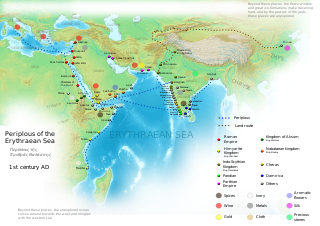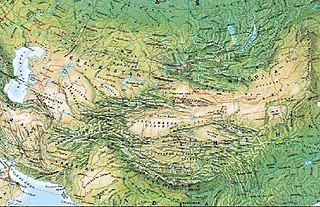Related Research Articles

Magadha also called the Kingdom of Magadha or the Magadha Empire, was a kingdom and empire, and one of the sixteen Mahajanapadas, 'Great Footholds of the People' during the Second Urbanization period, based in southern Bihar in the eastern Ganges Plain, in Ancient India. Magadha was ruled by the Brihadratha dynasty, the Pradyota dynasty, the Haryanka dynasty, the Shaishunaga dynasty, the Nanda dynasty, the Mauryan dynasty, the Shunga dynasty, the Kanva dynasty and the Gupta Empire. Kanva dynasty lost much of its territory after being defeated by the Satavahanas of Deccan in 28 BCE and was reduced to a small principality around Pataliputra. However, with the rule of Gupta Empire, The Gupta Empire regained the Glory of Magadh. Under the Mauryas, Magadha became a pan-Indian empire, covering large swaths of the Indian subcontinent and Afghanistan. The Magadh under the Gupta Empire emerged as the most prosperous Kingdom in the History of Ancient India.

Greco-Buddhism or Graeco-Buddhism denotes a supposed cultural syncretism between Hellenistic culture and Buddhism developed between the 4th century BC and the 5th century AD in Gandhara, in present-day Pakistan and parts of north-east Afghanistan. While the Greco-Buddhist art shows clear Hellenistic influences, the majority of scholars do not assume a noticeable Greek influence on Gandharan Buddhism beyond the artistic realm.

The word Yona in Pali and the Prakrits, and the analogue Yavana in Sanskrit and Yavanar in Tamil, were words used in Ancient India to designate Greek speakers. "Yona" and "Yavana" are transliterations of the Greek word for "Ionians", who were probably the first Greeks to be known in India.

The Indo-Scythians were a group of nomadic people of Iranic Scythian origin who migrated from Central Asia southward into the northwestern Indian subcontinent: the present-day South Asian regions of Afghanistan, Pakistan, Eastern Iran and northern India. The migrations persisted from the middle of the second century BCE to the fourth century CE.
Vibhajyavāda is a term applied generally to groups of early Buddhists belonging to the Sthavira Nikāya, which split from the Mahāsāṃghika into two main groups: the Sarvāstivāda and the Vibhajyavāda, of which the latter are known to have rejected both Sarvāstivāda doctrines and the doctrine of Pudgalavada (personalism). During the reign of Ashoka, these groups possibly took part in missionary activity in Gandhara, Bactria, Kashmir, South India and Sri Lanka. By the third century CE, they had spread in Central Asia and South-East Asia. Their doctrine is expounded in the Kathavatthu.

The Kambojas were a southeastern Iranian people who inhabited the northeastern most part of the territory populated by Iranian tribes, which bordered the Indian lands. They only appear in Indo-Aryan inscriptions and literature, being first attested during the later part of the Vedic period.

The Mahājanapadas were sixteen kingdoms and aristocratic republics that existed in ancient India from the sixth to fourth centuries BCE, during the second urbanisation period.

Dakshinapatha is a historical region which is the ancient equivalent of the present-day Deccan. It can also mean:
The Rishikas was an ancient Kingdom of Central Asia and South Asia, who are mentioned in Hindu and Sanskrit literary texts, including the Mahabharata, the Ramayana, the Brhat-Samhita, the Markendeya Purana and Patanjali's Mahabhashya.
The Dvārakā–Kamboja route is an ancient land trade route that was an important branch of the Silk Road during antiquity and the early medieval era. It is referred to in Buddhist, Hindu, and Jain works. It connected the Kamboja Kingdom in today's Afghanistan and Tajikistan via Pakistan to Dvārakā (Dvaravati) and other major ports in Gujarat, India, permitting goods from Afghanistan and China to be exported by sea to southern India, Sri Lanka, the Middle East and Ancient Greece and Rome. The road was the second most important ancient caravan route linking India with the nations of the northwest.
Daradas were an ancient people who lived north and north-west to the Kashmir Valley. This kingdom is identified to be the Gilgit region, in the Gilgit-Baltistan region along the river Sindhu or Indus. They are often spoken along with the Kambojas. The Pandava hero Arjuna had visited this country of Daradas during his northern military campaign to collect tribute for Yudhishthira's Rajasuya sacrifice.
The Chinas are a people mentioned in ancient Indian literature, such as the Mahabharata, Manusmriti, and the Puranic literature.

The kingdom of Tushara, according to ancient Indian literature, such as the epic Mahabharata, was a land located beyond north-west India. In the Mahabharata, its inhabitants, known as the Tusharas, are depicted as mlechchas ("barbarians") and fierce warriors.
Aśmaka, or Pali Assaka, was a kingdom among the 16 Mahajanapadas mentioned in Buddhist literature, in inscriptions including the Ajāntā Caves, and in Sanskrit epic and Purānic literature. All other kingdoms were in the north, from Anga to Gandhara. An alternative theory states that Asmaka was not an independent southern kingdom, but referred instead to Asvaka—a nation in the north ruled by the Kambojas. The epic Mahabharata mentions that the king of the name Asmaka was the adopted son of Saudasa a king of Kosala and an Ikshwaku ruler.

The Pahlavas are a people mentioned in ancient Indian texts. According to Patrick Carnegy, a Raj-era ethnographer, the 4th-century BCE Vartika of Katyayana mentions the Sakah-Parthavah, demonstrating an awareness of these Saka-Parthians, probably by way of commerce. Knowledge of the Pahlavas is distilled from the literary references in texts like the Manu Smriti, various Puranas, the Ramayana, the Mahabharata, and the Bṛhat Saṃhitā.

The Bahlikas were the inhabitants of a location called Bahlika, mentioned in the Atharvaveda, Mahabharata, Ramayana, Puranas, Vartikka of Katyayana, Brhatsamhita, Amarkosha, and other ancient inscriptions. Other variations of Bahlika include Bahli, Balhika, Vahlika, Valhika, Bahlava, Bahlam/Bahlim, Bahlayana, and Bahluva.
Mahākapphina (Pali) or Mahākapphiṇa (Sanskrit), also called Mahā Kapphina Thera, was an eminent Arhat from Uttarapatha and is considered foremost among those who taught the monks. Mahākapphina was his monastic name. He became disciple of the Buddha and is one of the five hundred Arhats who will be reborn and attain Buddhahood, according to Mahāyāna tradition. References to Kapphina can be found in the Jātakas, Buddhaghoṣa's Manorathapūranī, the Dhammapada Aṭṭhakathā, the Visuddhimagga, the Sāratthappakāsinī, the Saṃyutta Nikāya, the Aṅguttara Nikāya, the Vinaya Piṭaka, the Theragāthā, etc.; as well as in the Sanskrit Avadānaśatika.

Central Asia and Ancient India have long traditions of social-cultural, religious, political and economic contact since remote antiquity. The two regions have common and contiguous borders, climatic continuity, similar geographical features and geo-cultural affinity. For millennia, there has been a flow of people, material and ideas between the two.

Trapusa and Bahalika are traditionally regarded as the first disciples of the Buddha. The first account of Trapusa and Bahalika appears in the Vinaya section of the Tripiṭaka where they offer the Buddha his first meal after enlightenment, take refuge in the Dharma, and become the Buddha's first disciples. According to the Pali canon, they were caravan drivers from Puṣkalāvatī, in ukkalapada on way to Uttarapatha. However, most ancient Buddhist texts state that they came from Orissa or Burma i.e. modern Myanmar. Xuanzang (玄奘) says that Buddhism was brought to Central Asia by Trapusa and Bahalika, two Burmese merchants who offered food to the Buddha after his enlightenment.
Girihandu Seya is an ancient Buddhist temple situated in Thiriyai, Trincomalee, Sri Lanka. The temple is supposed to be the first Buddhist Stupa in Sri Lanka, believed to be constructed by two seafaring merchants Trapusa and Bahalika. The names of the two merchants are recorded in a rock inscription found in the Vihara premises. According to the inscription, Girihandu Seya was built by the guilds of merchants named Trapassuka and Vallika where the names are written as Tapassu and Bhalluka in later Sinhala chronicles. Some scholars also hold the view that Mahayana influenced seafaring merchants from the Pallava Kingdom were responsible for the construction of this temple.
References
- ↑ Centre, UNESCO World Heritage. "Sites along the Uttarapath, Badshahi Sadak, Sadak-e-Azam, Grand Trunk Road". UNESCO World Heritage Centre. Retrieved 2023-06-26.
- ↑ Ref: Vipassana Newsletter Vol. 7, No. 10 Dec 97.
- ↑ "Online Buddhist Dictionary of Pali Proper Names". Palikanon.com. Retrieved 2012-09-19.
- ↑ Sanjeev, Sanyal (2012-11-15). Land of the Seven Rivers: A Brief History of India's Geography. Penguin Random House India Private Limited. pp. 71–76. ISBN 9788184756715.